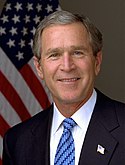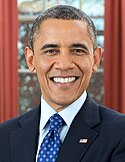Post-presidency

Activities
Some former presidents have had significant careers after leaving office. Prominent examples include William Howard Taft's tenure as chief justice of the United States and Herbert Hoover's work on government reorganization after World War II. Grover Cleveland, whose bid for reelection failed in 1888, was elected president again 4 years later in 1892. Two former presidents served in Congress after leaving the White House: John Quincy Adams was elected to the House of Representatives, serving there for 17 years, and Andrew Johnson returned to the Senate in 1875, though he died soon after. Some ex-presidents were very active, especially in international affairs, most notably Theodore Roosevelt; Herbert Hoover; Richard Nixon; and Jimmy Carter.
Presidents may use their predecessors as emissaries to deliver private messages to other nations or as official representatives of the United States to state funerals and other important foreign events. Richard Nixon made multiple foreign trips to countries including China and Russia and was lauded as an elder statesman. Jimmy Carter has become a global human rights campaigner, international arbiter, and election monitor, as well as a recipient of the Nobel Peace Prize. Bill Clinton has also worked as an informal ambassador, most recently in the negotiations that led to the release of two American journalists, Laura Ling and Euna Lee, from North Korea. During his presidency, George W. Bush called on former Presidents Bush and Clinton to assist with humanitarian efforts after the 2004 Indian Ocean earthquake and tsunami. President Obama followed suit by asking Presidents Clinton and Bush to lead efforts to aid Haiti after an earthquake devastated that country in 2010.
Clinton has also been active politically since his presidential term ended, working with his wife Hillary on her 2008 and 2016 presidential bids and President Obama on his 2012 reelection campaign.
Pension, office, and staff
Until 1958, former presidents had no governmental aid to maintain themselves. Gradually, a small pension was increased, but with the public disaffection with Presidents Johnson and Nixon, some began to question the propriety and the amounts involved.
Under the Former Presidents Act, all living former presidents are granted a pension, an office, and a staff. The pension has increased numerous times with congressional approval. Retired presidents now receive a pension based on the salary of the current administration's cabinet secretaries, which was $199,700 each year in 2012. Former presidents who served in Congress may also collect congressional pensions. The act also provides former presidents with travel funds and franking privileges. Prior to 1997, all former presidents, their spouses, and their children until age 16 were protected by the Secret Service until the president's death. In 1997, Congress passed legislation limiting Secret Service protection to no more than 10 years from the date a president leaves office. On January 10, 2013, President Obama signed legislation reinstating lifetime Secret Service protection for him, George W. Bush, and all subsequent presidents. A first spouse who remarries is no longer eligible for Secret Service protection.
As of December 2020update, there are four living former U.S. presidents. The most recent former president to die was George H. W. Bush (1989–1993), on November 30, 2018. The living former presidents, in order of service, are:
 Jimmy Carter
Jimmy Carter
(1977–1981)
Age 96 Bill Clinton
Bill Clinton
(1993–2001)
Age 74 George W. Bush
George W. Bush
(2001–2009)
Age 74 Barack Obama
Barack Obama
(2009–2017)
Age 59
Presidential libraries
Every president since Herbert Hoover has created a repository known as a presidential library for preserving and making available his papers, records, and other documents and materials. Completed libraries are deeded to and maintained by the National Archives and Records Administration (NARA); the initial funding for building and equipping each library must come from private, non-federal sources. There are currently thirteen presidential libraries in the NARA system. There are also presidential libraries maintained by state governments and private foundations and Universities of Higher Education, such as the Abraham Lincoln Presidential Library and Museum, which is run by the State of Illinois; the George W. Bush Presidential Library and Museum, which is run by Southern Methodist University; the George H. W. Bush Presidential Library and Museum, which is run by Texas A&M University; and the Lyndon Baines Johnson Presidential Library and Museum, which is run by the University of Texas at Austin.
A number of presidents have lived for many years after leaving office, and several of them have personally overseen the building and opening of their own presidential libraries. Some have even made arrangements for their own burial at the site. Several presidential libraries contain the graves of the president they document, including the Dwight D. Eisenhower Presidential Library, Museum and Boyhood Home in Abilene, Kansas, Richard Nixon Presidential Library and Museum in Yorba Linda, California, and the Ronald Reagan Presidential Library in Simi Valley, California. These gravesites are open to the general public.




Comments
Post a Comment